
The Isle of Sheppey is an island off the northern coast of Kent, England, neighbouring the Thames Estuary, centred 42 miles (68 km) from central London. It has an area of 36 square miles (93 km2). The island forms part of the local government district of Swale. Sheppey is derived from Old English Sceapig, meaning "Sheep Island".
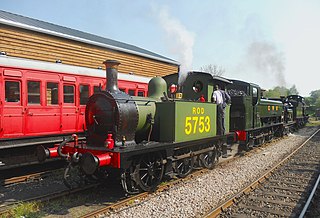
The Kent and East Sussex Railway (K&ESR) refers to both a historical private railway company in Kent and East Sussex in England, as well as a heritage railway currently running on part of the route of the historical company.

Sheerness is a town and civil parish beside the mouth of the River Medway on the north-west corner of the Isle of Sheppey in north Kent, England. With a population of 11,938, it is the second largest town on the island after the nearby town of Minster which has a population of 21,319.
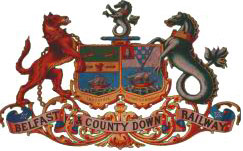
The Belfast and County Down Railway (BCDR) was an Irish gauge railway in Ireland linking Belfast with County Down. It was built in the 19th century and absorbed into the Ulster Transport Authority in 1948. All but the line between Belfast and Bangor was closed in the 1950s, although some of it has been restored near Downpatrick by a heritage line, the Downpatrick and County Down Railway.

Eastchurch is a village and civil parish on the Isle of Sheppey, in the English county of Kent, two miles east of Minster. The village website claims the area has "a history steeped in stories of piracy and smugglers".
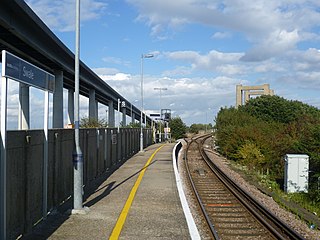
The Sheerness line is located in Kent, England, and connects Sheerness-on-Sea on the Isle of Sheppey with Sittingbourne on the mainland, and with the Chatham Main Line for trains towards London, Ramsgate or Dover Priory. It opened on 19 July 1860.

Swale railway station is in north Kent, England, on the Sheerness Line 47 miles 15 chains (75.9 km) from London Victoria, at the southern end of the Kingsferry Bridge which, along with the more modern Sheppey Crossing, connects the Isle of Sheppey to mainland Kent. The nearest settlement is Iwade. Train services are provided by Southeastern.

Queenborough railway station is on the Sheerness Line, on the Isle of Sheppey in northern Kent, and serves the town of Queenborough. It is 49 miles 22 chains (79.3 km) down the line from London Victoria.

Three Oaks railway station serves the village of Three Oaks in East Sussex, England. It is on the Marshlink Line, and train services are provided by Southern. It was originally known as Three Oaks & Guestling.

The Campbeltown and Machrihanish Light Railway was a 2 ft 3 in narrow gauge railway in Kintyre, Scotland, between Campbeltown and the coalmining village of Machrihanish. Only three other passenger-carrying lines in the UK operated on the same gauge, all of them in Wales - the Corris Railway, the short-lived Plynlimon and Hafan Tramway and the Talyllyn Railway.
Queenborough-in-Sheppey was a municipal borough in Kent, England from 1968 to 1974. It was created by a merger of the Municipal Borough of Queenborough with Sheerness Urban District and Sheppey Rural District, and occupied the entire Isle of Sheppey. It incorporated the following parishes:
Railmotor is a term used in the United Kingdom and elsewhere for a railway lightweight railcar, usually consisting of a railway carriage with a steam traction unit, or a diesel or petrol engine, integrated into it.

Leysdown-on-Sea is a village on the east coast of the Isle of Sheppey in the borough of Swale in Kent, England. In 2020 it had an estimated population of 936. The civil parish is Leysdown and includes the settlements of Bay View, Shellness and Harty. In 2011 it had a population of 1,256.
Transportation needs within the county of Kent in South East England has been served by both historical and current transport systems.
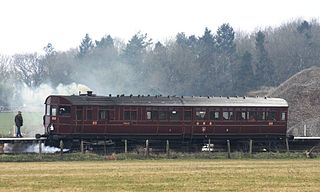
The steam rail motors (SRM) were self-propelled carriages operated by the Great Western Railway in England and Wales from 1903 to 1935. They incorporated a steam locomotive within the body of the carriage.

The Gulflander is a passenger train operated by Queensland Rail on the isolated Normanton to Croydon line in the Gulf Country of northern Queensland, Australia.
Royal Air Force Eastchurch or more simply RAF Eastchurch is a former Royal Air Force station near Eastchurch village, on the Isle of Sheppey, Kent, England. The history of aviation at Eastchurch stretches back to the first decade of the 20th century when it was used as an airfield by members of the Royal Aero Club. The area saw the first flight by a British pilot in Britain.

A steam railcar is a rail vehicle that does not require a locomotive as it contains its own steam engine. The first steam railcar was an experimental unit designed and built in 1847 by James Samuel and William Bridges Adams. In 1848 they made the Fairfield steam carriage that they sold to the Bristol & Exeter Railway, who used it for two years on a branch line.
The National Cycle Route 174 is part of the National Cycle Network in the United Kingdom. Part of it is known as The Sheerness Way.
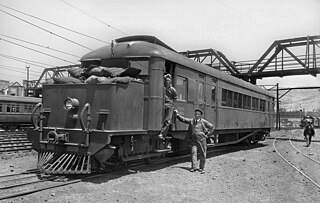
The South African Railways Clayton Railmotor of 1929 was a steam railmotor.















